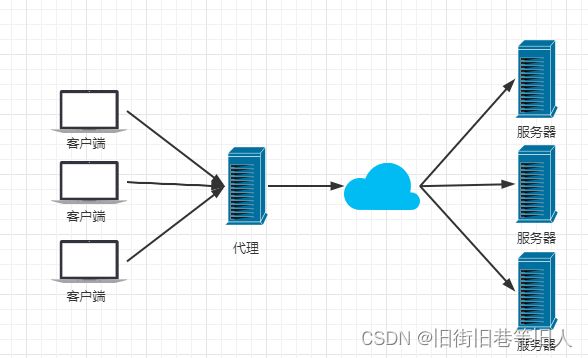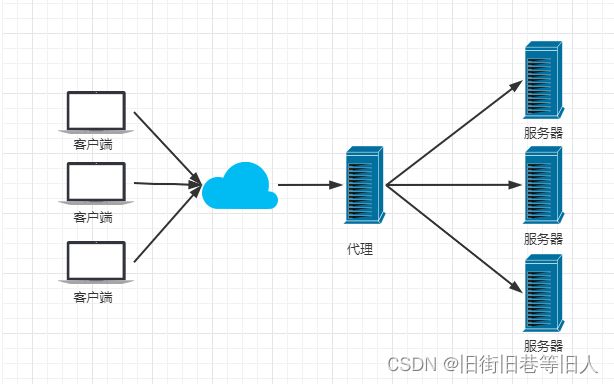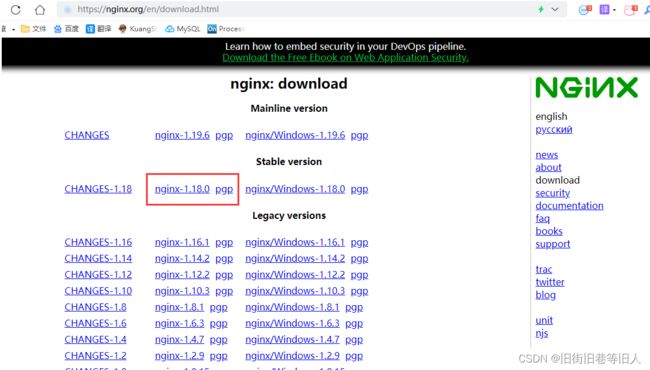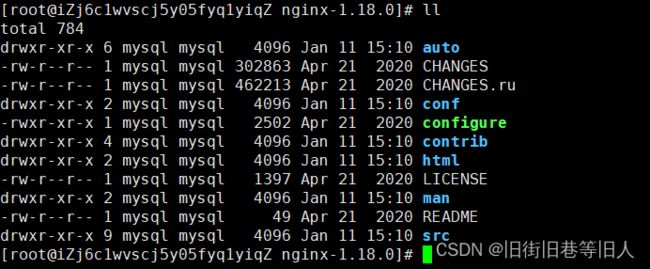Nginx反向代理及负载均衡
nginx和gateway的区别
- 相同点
○ 它们都可以用于反向代理和负载均衡 - 不同点
- 设计目的:
■ nginx主要设计目的是作为web服务器和反向代理服务器使用
■ gateway的主要设计目的是用于构建和管理微服务的API网关 - 功能不同
■ Nginx提供了HTTP/HTTPS等协议的支持,包括静态资源的请求、动态网页的处理、反向代理、负载均衡、HTTP缓存等功能
■ Gateway提供了路由、负载均衡、API转换、认证授权等管理微服务的功能 - 使用场景
■ Nginx的使用场景主要集中在Web服务器、API服务器、CDN等领域
■ Gateway的使用场景主要集中在微服务架构、云原生应用等领域 - 配置方式
■ Nginx的配置文件主要基于纯文本格式,配置灵活但有一定门槛
■ Gateway则更多地采用了视觉化的配置方式,简化了配置过程
- 设计目的:
两张图体会为何要用nginx
最开始项目上线时并发量小,用户使用的少,所以在低并发的情况下,一个jar包启动应用就够了,然后内部tomcat返回内容给用户。

但是慢慢的,平台用户量越来越大,并发量也随之增高,一台服务器已经满足不了我们的需求了

于是我们横向扩展,又增加了服务器。这个时候几个项目启动在不同的服务器上,用户要访问,就需要增加一个代理服务器了,通过代理服务器来帮我们转发和处理请求。
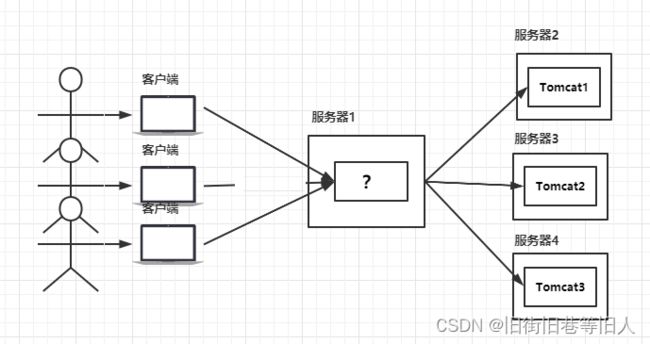
我们希望这个代理服务器可以帮助我们接收用户的请求,然后将用户的请求按照规则帮我们转发到不同的服务器节点之上。这个过程用户是无感知的,用户并不知道是哪个服务器返回的结果,我们还希望他可以按照服务器的性能提供不同的权重选择。保证最佳体验!所以我们使用了Nginx。
nginx作用
-
代理功能
正向代理的请求的流转过程:
- 客户端向代理服务器发起请求,请求中包含了需要访问的目标服务器的地址和端口号,但是不包含客户端的真实IP地址。
- 代理服务器接收到请求后,代表客户端向目标服务器发起请求。这一步中,代理服务器的IP地址会被目标服务器记录为请求的IP地址,而请求中并不包含客户端的真实IP地址。
- 目标服务器将响应返回给代理服务器,响应中包含了客户端需要的资源或者其他信息。
- 代理服务器接收到响应后,将响应返回给客户端。客户端并不知道响应是从代理服务器发出的。
- 客户端向反向代理服务器发起请求,请求中包含了需要访问的资源的地址和端口号,以及一些HTTP头信息,如HOST,Cookie等等。
- 反向代理服务器收到请求信息后,将请求转发到后端服务器群组中的一台或多台目标服务器上。
- 后端服务器接收到请求后,处理请求并产生响应,返回给反向代理服务器。
- 反向代理服务器接收到后端服务器的响应后,对响应头信息和内容进行处理,然后将响应返回给客户端。
整个过程中,外部流量的访问请求都由反向代理服务器接收,后端的服务器业务逻辑都被隐藏在反向代理服务器后面,从而保证了服务器的安全性。在请求发送到后端服务器时,反向代理服务器会根据一定的负载均衡策略,将请求分配到不同的后端服务器上,从而达到了负载均衡目的。
负载均衡策略
nginx提供2种负载均衡策略:
- 内置策略
- 加权轮询
- IP hash
- 扩展策略
- 扩展策略相当于自定义,天马行空,只有你想不到的没有他做不到的
动静分离
在软件开发中,有些请求时需要后台处理的,有些请求是不需要经过后台处理的,例如css、html、jpg、js等,这些不需要经过后台处理的文件称为静态文件。动静资源做好拆分后,我们就可以根据静态资源的特点将其做缓存操作,提高资源响应速度。
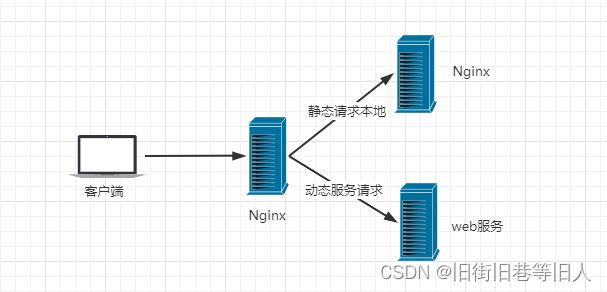
nginx安装
- windows环境
-
下载
http://nginx.org/en/download.html 下载稳定版本。
以nginx/Windows-1.16.1为例,直接下载 nginx-1.16.1.zip。
下载后解压,解压后如下:

-
启动nginx
有很多种方法启动nginx
(1)直接双击nginx.exe,双击后一个黑色的弹窗一闪而过
(2)打开cmd命令窗口,切换到nginx解压目录下,输入命令 nginx.exe ,回车即可 -
检查nginx是否成功启动
直接在浏览器地址栏输入网址 http://localhost:80 回车,出现以下页面说明启动成功!

nginx的配置文件是conf目录下的nginx.conf,默认配置的nginx监听的端口为80,如果80端口被占用可以修改为未被占用的端口即可。 -
关闭nginx
如果使用cmd命令窗口启动nginx, 关闭cmd窗口是不能结束nginx进程的,可使用两种方法关闭nginx
(1)输入nginx命令 nginx -s stop(快速停止nginx) 或 nginx -s quit(完整有序的停止nginx)
(2)使用taskkill taskkill /f /t /im nginx.exe
taskkill是用来终止进程的,
/f是强制终止 .
/t终止指定的进程和任何由此启动的子进程。
/im示指定的进程名称 .
- Linux环境
- 安装gcc
安装 nginx 需要先将官网下载的源码进行编译,编译依赖 gcc 环境,如果没有 gcc 环境,则需要安装:
yum install gcc-c++
- PCRE pcre-devel 安装
PCRE(Perl Compatible Regular Expressions) 是一个Perl库,包括 perl 兼容的正则表达式库。nginx 的 http 模块使用 pcre 来解析正则表达式,所以需要在 linux 上安装 pcre 库,pcre-devel 是使用 pcre 开发的一个二次开发库。nginx也需要此库。命令:
yum install -y pcre pcre-devel
- zlib安装
zlib 库提供了很多种压缩和解压缩的方式, nginx 使用 zlib 对 http 包的内容进行 gzip ,所以需要在 Centos 上安装 zlib 库。
yum install -y zlib zlib-devel
- OpenSSL安装
OpenSSL 是一个强大的安全套接字层密码库,囊括主要的密码算法、常用的密钥和证书封装管理功能及 SSL 协议,并提供丰富的应用程序供测试或其它目的使用。
nginx 不仅支持 http 协议,还支持 https(即在ssl协议上传输http),所以需要在 Centos 安装 OpenSSL 库。
yum install -y openssl openssl-devel
tar -zxvf nginx-1.18.0.tar.gz
cd nginx-1.18.0
- 配置
使用默认配置,在nginx根目录下执行
./configure
make
make install
如果报错,需要在第一个命令中加入 ./configure --prefix=/usr/local/nginx
查找安装路径: whereis nginx
![]()
如何启动
[root@localhost nginx-1.20.2]# cd /usr/local/nginx/
[root@localhost nginx]# ls
conf html logs sbin
[root@localhost nginx]# cd sbin/
[root@localhost sbin]# ls
nginx nginx.old
[root@localhost sbin]# ./nginx
nginx常用命令
cd /usr/local/nginx/sbin/
./nginx 启动
./nginx -s stop 停止
./nginx -s quit 安全退出
./nginx -s reload 重新加载配置文件
ps aux|grep nginx 查看nginx进程
启动成功访问 服务器ip:80

如果连接不上,检查阿里云安全组是否开放端口,或者服务器防火墙是否开放端口!
相关命令:
# 开启
service firewalld start
# 重启
service firewalld restart
# 关闭
service firewalld stop
# 查看防火墙规则
firewall-cmd --list-all
# 查询端口是否开放
firewall-cmd --query-port=8080/tcp
# 开放80端口
firewall-cmd --permanent --add-port=80/tcp
# 移除端口
firewall-cmd --permanent --remove-port=8080/tcp
#重启防火墙(修改配置后要重启防火墙)
firewall-cmd --reload
# 参数解释
1、firwall-cmd:是Linux提供的操作firewall的一个工具;
2、--permanent:表示设置为持久;
3、--add-port:标识添加的端口;
nginx配置详解
默认的nginx配置文件nginx.conf内容如下:
##### 全局块
#user nobody;
worker_processes 1;
#error_log logs/error.log;
#error_log logs/error.log notice;
#error_log logs/error.log info;
#pid logs/nginx.pid;
##### events块
events {
worker_connections 1024;
}
##### http块
http {
###### http的全局块
include mime.types;
default_type application/octet-stream;
#log_format main '$remote_addr - $remote_user [$time_local] "$request" '
# '$status $body_bytes_sent "$http_referer" '
# '"$http_user_agent" "$http_x_forwarded_for"';
#access_log logs/access.log main;
sendfile on;
#tcp_nopush on;
#keepalive_timeout 0;
keepalive_timeout 65;
#gzip on;
##### server块
server {
##### server的全局块
listen 80;
server_name localhost;
#charset koi8-r;
#access_log logs/host.access.log main;
##### location块
location / {
root html;
index index.html index.htm;
}
#error_page 404 /404.html;
# redirect server error pages to the static page /50x.html
#
error_page 500 502 503 504 /50x.html;
location = /50x.html {
root html;
}
# proxy the PHP scripts to Apache listening on 127.0.0.1:80
#
#location ~ \.php$ {
# proxy_pass http://127.0.0.1;
#}
# pass the PHP scripts to FastCGI server listening on 127.0.0.1:9000
#
#location ~ \.php$ {
# root html;
# fastcgi_pass 127.0.0.1:9000;
# fastcgi_index index.php;
# fastcgi_param SCRIPT_FILENAME /scripts$fastcgi_script_name;
# include fastcgi_params;
#}
# deny access to .htaccess files, if Apache's document root
# concurs with nginx's one
#
#location ~ /\.ht {
# deny all;
#}
}
# another virtual host using mix of IP-, name-, and port-based configuration
#
#server {
# listen 8000;
# listen somename:8080;
# server_name somename alias another.alias;
# location / {
# root html;
# index index.html index.htm;
# }
#}
# HTTPS server
#
#server {
# listen 443 ssl;
# server_name localhost;
# ssl_certificate cert.pem;
# ssl_certificate_key cert.key;
# ssl_session_cache shared:SSL:1m;
# ssl_session_timeout 5m;
# ssl_ciphers HIGH:!aNULL:!MD5;
# ssl_prefer_server_ciphers on;
# location / {
# root html;
# index index.html index.htm;
# }
#}
}
- 全局块:
配置影响nginx全局的指令。一般有运行nginx服务器的用户组,nginx进程pid存放路径,日志存放路径,配置文件引入,允许生成worker process数等 - events块:配置影响nginx服务器或与用户的网络连接。每个进程的最大连接数,选取哪种时间驱动模型处理连接请求,是否允许同时接受多个网络连接,开启多个网络连接序列化等
- http块:可以嵌套多个server块,配置代理,缓存,日志定义等绝大多数功能和第三方模块的配置。如文件引入,mime-type定义,日志自定义,是否使用sendfile传输文件,连接超时时间,但链接请求数等
- server块:配置虚拟主机的相关参数,一个http中可以有多个server块
- location块:配置请求的路由,及各种页面的处理情况
示例
########### 每个指令必须有分号结束。#################
#配置用户或者组,默认为nobody nobody。
#user administrator administrators;
#允许生成的进程数,默认为1
#worker_processes 2;
#指定nginx进程运行文件存放地址
#pid /nginx/pid/nginx.pid;
#制定日志路径,级别。这个设置可以放入全局块,http块,server块
#日志级别依次为:debug|info|notice|warn|error|crit|alert|emerg
error_log log/error.log debug;
events {
#设置网路连接序列化,防止惊群现象发生,默认为on
accept_mutex on;
#设置一个进程是否同时接受多个网络连接,默认为off
multi_accept on;
#事件驱动模型,select|poll|kqueue|epoll|resig|/dev/poll|eventport
#use epoll;
#最大连接数,默认为512
worker_connections 1024;
}
http {
#文件扩展名与文件类型映射表
include mime.types;
#指定默认文件类型,默认为text/plain
default_type application/octet-stream;
#取消服务日志
#access_log off;
#下面是日志的自定义格式
log_format myFormat '$remote_addr–$remote_user [$time_local] $request $status $body_bytes_sent $http_referer $http_user_agent $http_x_forwarded_for';
#combined为日志格式的默认值
access_log log/access.log myFormat;
#允许sendfile方式传输文件,默认为off,可以在http块,server块,location块。
sendfile on;
#每个进程每次调用传输数量不能大于设定的值,默认为0,即不设上限。
sendfile_max_chunk 100k;
#连接超时时间,默认为75s,可以在http,server,location块。
keepalive_timeout 65;
upstream mysvr {
server 127.0.0.1:7878;
server 192.168.10.121:3333 backup; #热备
}
#指定错误页
error_page 404 https://www.baidu.com;
server {
#单连接请求上限次数。
keepalive_requests 120;
listen 4545; #监听端口
server_name 127.0.0.1; #监听地址
location ~*^.+$ { #请求的url过滤,正则匹配,~为区分大小写,~*为不区分大小写。
#root path; #根目录
#index vv.txt; #设置默认页
proxy_pass http://mysvr; #请求转向mysvr 定义的服务器列表
deny 127.0.0.1; #拒绝的ip
allow 172.18.5.54; #允许的ip
}
}
}
配置nginx需要注意以下几点:
1、几个常见配置项
● $remote_addr 与 $http_x_forwarded_for 用以记录客户端的ip地址;
● $remote_user :用来记录客户端用户名称;
● $time_local : 用来记录访问时间与时区;
● $request : 用来记录请求的url与http协议;
● $status : 用来记录请求状态;成功是200;
● $body_bytes_s ent :记录发送给客户端文件主体内容大小;
● $http_referer :用来记录从那个页面链接访问过来的;
● $http_user_agent :记录客户端浏览器的相关信息;
2、惊群现象:
一个网络连接的到来,多个睡眠进程同时被叫醒,但只有一个进程能获得链接,这样会影响系统性能
3、每个指令必须有分号作为结束
以下是一个更多转发的server块的示例:
server {
listen 80;
listen [::]:80;
server_name _;
root /usr/share/nginx/html;
# Load configuration files for the default server block.
include /etc/nginx/default.d/*.conf;
error_page 404 /404.html;
location = /404.html {
}
error_page 500 502 503 504 /50x.html;
location = /50x.html {
}
location ^~ /iotsaas/ {
rewrite ^/iotsaas/(.*)$ /$1 break;
proxy_pass http://localhost:8097;
client_max_body_size 100m;
}
location ^~ /iotpaas/ {
rewrite ^/iotpaas/(.*)$ /$1 break;
proxy_pass http://localhost:8086;
}
location ^~ /hwnfctest/ {
rewrite ^/hwnfctest/(.*)$ /$1 break;
proxy_pass http://localhost:32018;
}
location ^~ /urumqi_apartment/ {
rewrite ^/urumqi_apartment/(.*)$ /$1 break;
proxy_pass http://localhost:20010;
}
}
下面是几种负载均衡的配置示例
轮询模式
upstream中如果按以下这样配置则是默认的轮询效果
upstream mysvr {
server 127.0.0.1:7878;
server 192.168.10.121:3333 backup; #热备
}
权重模式
如果要使用权重模式,那么是这样配置
upstream webservers{
server 192.168.9.134:8081 weight=8;
server 192.168.9.134:8082 weight=2;
}
ip_hash
每个请求按访问IP的hash结果进行分配,这样每个访客就可以固定访问一个后端服务,一定程度上可以解决session共享问题;
upstream tomcats {
ip_hash;
server 192.168.93.129:8080;
server 192.168.93.130:8080;
server 192.168.93.131:8080;
}
在ip_hash中如果要停掉某一台服务器,不能直接删除,应该使用down
upstream tomcats {
ip_hash;
server 192.168.93.129:8080;
server 192.168.93.130:8080 down;
server 192.168.93.131:8080;
}
fair(第三方)
按后端服务器的响应时间来分配请求,响应时间短的将会被优先分配
upstream webservers{
server 192.168.9.134:8081;
server 192.168.9.134:8082;
fair;
}
url_hash
按访问URL的hash结果分配。这样相同的url会被分配到同一个节点,主要为了提高缓存命中率。比如,为了提高访问性能,服务端有大量数据或者资源文件需要被缓存。使用这种策略,可以节省缓存空间,提高缓存命中率
upstream webservers{
hash &request_uri;
server 192.168.9.134:8081;
server 192.168.9.134:8082;
}
least_conn
按节点连接数分配,把请求优先分配给连接数少的节点。该策略主要为了解决,各个节点请求处理时间长短不一造成某些节点超负荷的情况。
upstream webservers{
least_conn;
server 192.168.9.134:8081;
server 192.168.9.134:8082;
}
